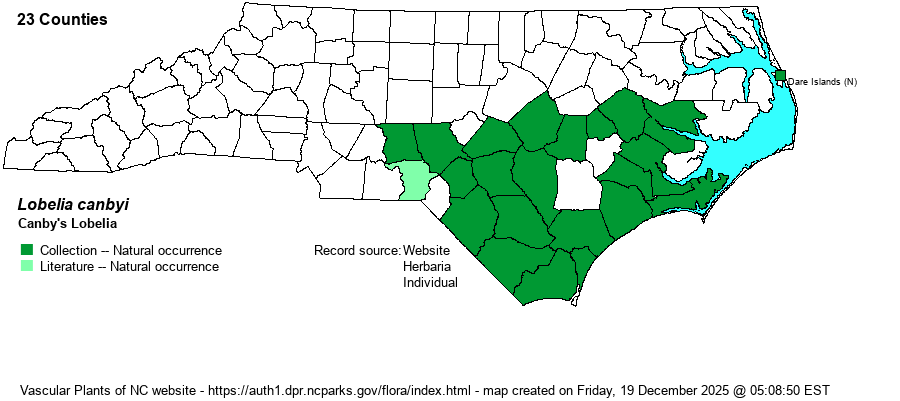| Author | A. Gray | |
| Distribution | Essentially throughout the southern half of the Coastal Plain, including a disjunct record for northern coastal Dare County. It is scarce in the Sandhills proper.
This is a Southeastern species with oddly disjunct regions of occurrence. It ranges from NJ to eastern MD, then from eastern NC to GA, and also in parts of southeastern TN.
| |
| Abundance | Fairly common to locally common in some well-managed pinelands from Craven and Carteret counties to the SC line. Uncommon to infrequent farther inland and northward, being generally less numerous than L. nuttallii where both species occur. | |
| Habitat | This is a species of damp ground, often in pine savannas, but it also grows in pools, clay-based bays, around limesink ponds, and cypress savannas. | |
| Phenology | Blooms from July to frost, and fruits shortly after flowering. | |
| Identification | This is one of three very similar Lobelia species with very slender stems and narrow leaves, quite different from most of the other more robust species. This is a very slender, erect species, smooth, and usually branched in the upper portion. It has scattered alternate leaves, about 1-2 inches long but narrow, about 1/10-inch wide. The raceme of flowers is quite open and about 4-6 inches long, with small light to medium blue flowers and a white center. In this species, the flower stalks are very slender but are about as long the equally slender bract beneath it. This species does have a bracteole at the base of each bract, as does L. nuttallii, whereas the very similar L. boykinii does not. The flowers of all three are similar, and each is about 1/3-1/2-inch long, most of that being the narrow floral tube, though they do have flaring lobes. Another key separating character is that L. boykinii leaves are filiform and barely measurable in width, and they usually drop by flowering; the other two have linear leaves (though barely 1/10-inch wide), but they are persistent through flowering. This species and L. nuttallii are quite numerous, at least locally, and the main separation characters are that L. canbyi has the lower lip of the flower pubescent inside at the base of the throat, whereas L. nuttallii is glabrous there; and L. canbyi has sharp hairs on the pedicels and calyx but L. nuttallii has none or hairs mostly lie flat. Finally, the lower leaves of L. nuttallii are narrowly oblanceolate and not simply linear; this can be readily observable if you pay attention to this part of the plant. You may have trouble separating these two species, unless you have a hand lens! | |
| Taxonomic Comments | None
| |
| Other Common Name(s) | None | |
| State Rank | S3? [S4] | |
| Global Rank | G4 | |
| State Status | | |
| US Status | | |
| USACE-agcp | OBL link |
| USACE-emp | OBL link |

